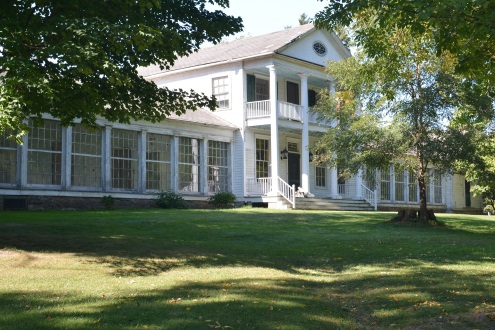
Fort Ticonderoga’s Pavilion is located on the shore of Lake Champlain below the Fort.
A very historic building lies on the grounds of Fort Ticonderoga that many people don’t know anything about. Located below the Fort, on the shore of Lake Champlain, stands the Pavilion. It was built as a summer home in 1826 by William Ferris Pell. He and his family occupied it through the 1830s.
By 1840 the house had begun to be used as a hotel, its primary function through 1900. As a hotel the house welcomed travelers passing through Ticonderoga while traveling by steamboat on Lake George and Lake Champlain. The hotel is known to have accommodated such guests as Robert Todd Lincoln, son of President Abraham Lincoln; the prominent French & Indian War historian, Francis Parkman; and prolific Adirondack photographer, Seneca Ray Stoddard. When William Ferris Pell’s great-grandson, Stephen H.P. and his wife Sarah G.T. Pell began the restoration of Fort Ticonderoga in 1909, they simultaneously undertook the restoration of the Pavilion and used the house as a summer residence for many years. After Stephen Pell’s death in 1950 his son John occupied the house until 1987.
The design phase for Fort Ticonderoga’s Pavilion, is now underway thanks to a grant from the New York Council on the Arts and generous individual donor support. John G. Waite Associates, Architects PLLC, a leading consultant in the field of historic preservation architecture, has been hired to prepare schematic design and design development documents for the historic home located on Fort Ticonderoga property. The documents will allow Fort Ticonderoga to move forward with the stabilization and complete restoration of this nationally significant building as part of their overall site master plan.
Plans for the Pavilion’s reuse include meeting space, hospitality functions, administrative support, dining, and guest services. The Pavilion’s restoration is part of a larger multi-year capital initiative being undertaken by Fort Ticonderoga.
“Fort Ticonderoga is extremely pleased to begin this important project,” said Beth Hill, Fort Ticonderoga President and CEO. “As one of the earliest summer homes and hotels in the region, the Pavilion is considered one of the most important historic structures in the Adirondacks. The Pavilion is a critical link spanning nearly two centuries of Fort Ticonderoga’s history encompassing the stories of landmark preservation, the birth of American tourism, and monumental restoration.”
Although much of the Pavilion’s early fabric remains, the building has been altered over the years and today is in poor condition because of decades of little or no maintenance. Interior features have deteriorated along with elements of the building’s exterior. Without stabilization and rehabilitation work, the building would be in jeopardy of being lost, making this project vital and timely.
A team of architects, architectural historians, and building conservators from John G. Waite Associates carried out a thorough investigation of the Pavilion in 2013-2014, to document and understand the current state of the building and identify the various phases of the building’s evolution. Dendrochronology was conducted on timbers in the structure during that time and identified beams dating from the late 17th century, 18th century, and 19th century. The research provided the foundation for future plans of restoration and reuse.
